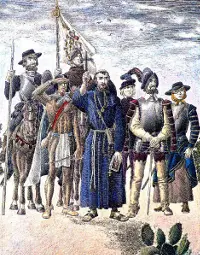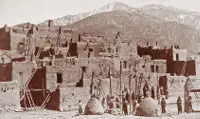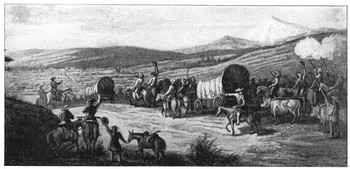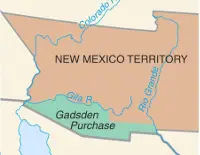The Making of the 50 States: New Mexico
Part 1: In the Beginning
As with other western states, Francisco Vásquez de Coronado of Spain is the first known European to have stayed any length of time in what is now New Mexico. Coronado was on the hunt for the fabled Seven Cities of Gold. Some state histories tell of an earlier set of Spanish explorers, a group of survivors of a Gulf of Mexico shipwreck, led by the nobleman Alvan Nuñez Cabeza de Vaca, who wandered through the area in 1527. 
A 1580s expedition led by Bernardo Beltran and Antonio de Espejo explored much of the area; this expedition is thought to have been the first to use the term la Nueva Mejico. Don Juan de Oñate marched alongside the Rio Grande north in 1598, with a collection of troops and settlers in tow. They settled at the Native American village of Yungueingge and renamed it San Gabriel del Yunque; this became the first Spanish capital of new Mexico. The founding of Santa Fe as capital came in 1610, the result of actions by then-Governor Don Pedro de Peralta. A period of Spanish settlement ensued, punctuated by missionary efforts to convert the native peoples to Christianity. Many of these native peoples didn't take kindly to such encroachment on what had been their homelands, and a large revolt led by Taos Pueblo occurred in 1680, resulting in a Spanish withdrawal south. 
The Spanish returned a few years later, with more men and more tolerance. The Spanish established more settlements and enjoyed more civil relations with Native Americans, mostly. French trappers arrived in Santa Fe in 1743 and began trading with the Spanish. The changes taking part in the eastern and central parts of the United States had little effect on New Mexico and the west until the return of Lewis and Clark from the Pacific Coast in 1806 spurred exploration of all points west. An expedition led by the famous explorer Zebulon Pike arrived in 1807. 
When Mexico won its independence from Spain, New Mexico went with it. The development of the Santa Fe Trail soon followed. The discovery of gold in the mountains south of Santa Fe in 1828 increased settlement. As American settlers kept on arriving in the area, conflicts developed between those settlers and both Mexican authorities and Native Americans. A U.S. Army delegation led by Gen. Stephen Kearny in 1846 seized New Mexico, declaring it American territory. The Mexican-American War ensued. The Taos Rebellion in 1847 resulted in many deaths, including that of the governor, Charles Bent. The American victory in that war in 1848 resulted in most of New Mexico's being part of the Mexican Cession and part of the United States. 
Congress in 1850 created the Territory of New Mexico, which included most of what is now Arizona as well, and ordered the establishment of a new civil government. One of the foundations of the territory's laws was the Kearny Code, a set of military statutes set up by Stephen Kearney to govern new U.S. territories. In 1861, French bishop Jean Baptiste Lamy arrived and set about establishing hospitals, orphanages, and schools throughout the territory. He later became the first Archbishop of Santa Fe. The Gadsden Purchase in 1853 completed the boundary of modern New Mexico, adding a stripe of the land along the southern border. Next page > The Rest of the Story > Page 1, 2 |
|
Social Studies for Kids
copyright 2002–2024
David White



 The Anasazi, Clovis, Folom, Mogollon, and Pecos Cultures were the early settlers of what is now New Mexico. Later Native American tribes living in the area included the Apache, Comanche, Jemez, Kiowa, Manso, Navajo, Puebo, Ute, and Zuni.
The Anasazi, Clovis, Folom, Mogollon, and Pecos Cultures were the early settlers of what is now New Mexico. Later Native American tribes living in the area included the Apache, Comanche, Jemez, Kiowa, Manso, Navajo, Puebo, Ute, and Zuni.
